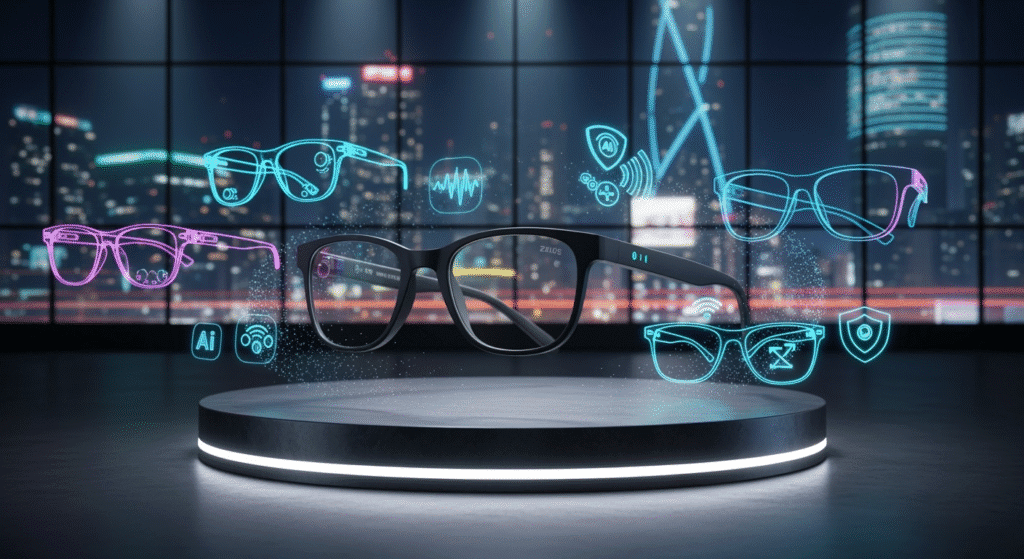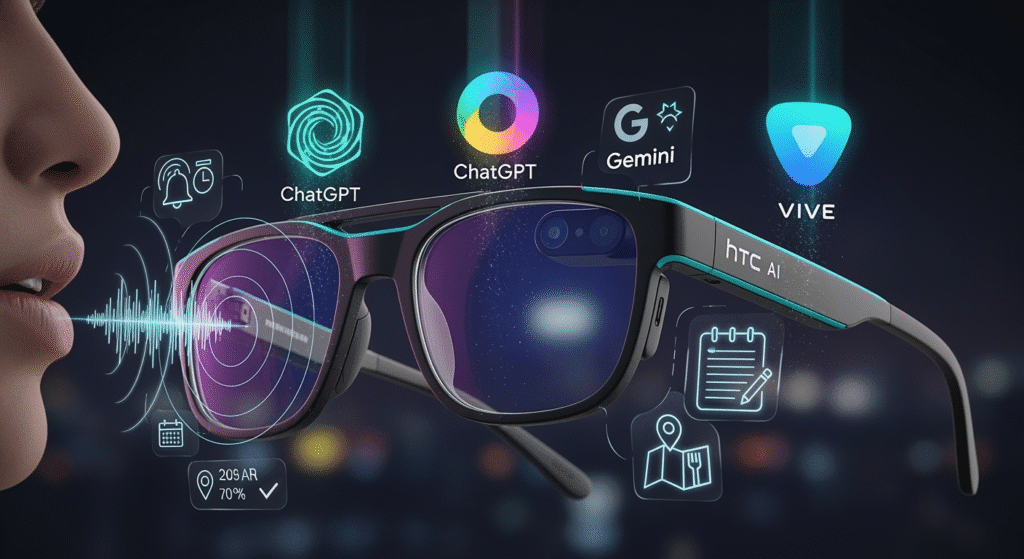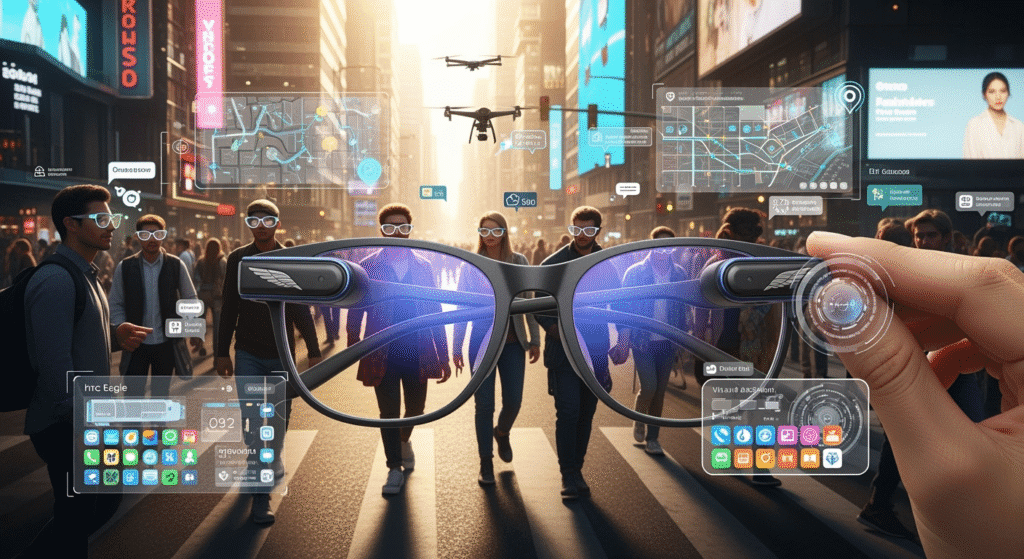The smart glasses revolution is heating up. HTC Corporation has officially thrown its hat into the ring with the launch of the Vive Eagle AI glasses, marking a significant entry into a market currently dominated by Meta’s Ray-Ban smart glasses. This move signals HTC’s ambitious return to consumer wearables and represents a direct challenge to tech giants who have been racing to perfect AI-powered eyewear.

The Smart Glasses Gold Rush
Smart glasses have become the latest battleground for tech companies. Meta has been leading the charge with its Ray-Ban collaboration, while Apple, Google, and Samsung have all signaled their intentions to enter this emerging market. Now HTC is positioning itself as a serious contender with a product that promises to deliver more than just basic AI functionality.
The timing couldn’t be more strategic. As consumers increasingly seek seamless integration between their digital and physical worlds, smart glasses represent the next frontier in wearable technology. Unlike smartphones that require users to look down at screens, smart glasses promise hands-free interaction with AI assistants while maintaining natural eye contact and awareness of surroundings.
Design Philosophy: Where Fashion Meets Function
HTC has clearly prioritized aesthetics with the Vive Eagle. Weighing just under 49 grams, these glasses are designed to blend seamlessly into everyday life. The company offers four distinct color options: Berry, Coffee, Grey, and Black, ensuring users can find a style that matches their personal aesthetic.
Charles Huang, Senior Vice President of HTC, emphasized this design philosophy: “VIVE Eagle represents HTC’s newest exploration in the realm of intelligent living and personal wearables. By combining our pursuit of design excellence with expertise in immersive user experiences, this product is more than just a pair of glasses — it’s a way to live life with greater freedom.”
The glasses feature adjustable nose pads and ergonomically contoured temples for all-day comfort. ZEISS sun lenses provide UV protection without compromising optical clarity, addressing a common concern among potential smart glasses users who worry about visual quality.
Technical Specifications That Matter
Under the hood, the Vive Eagle packs impressive technology into its lightweight frame. The centerpiece is a 12-megapixel ultra-wide camera that enables users to capture photos and videos with simple voice commands. The integration feels natural users can simply say “Hey VIVE, take a photo” to capture moments without fumbling for their phones.
The audio system deserves special attention. HTC has implemented an open-ear design with large acoustic drivers and virtual bass enhancement. This approach delivers rich, spatial audio while minimizing sound leakage a crucial feature for maintaining privacy in public spaces. The no-earplug design eliminates ear canal pressure, making extended wear comfortable while keeping users aware of their surroundings for safety.
Battery life addresses one of the biggest concerns with wearable devices. The 235mAh battery provides up to 36 hours of standby time and approximately 4.5 hours of continuous music playback. Perhaps more importantly, the magnetic fast charging system can deliver 50% power in just 10 minutes, making it practical for users to top up their glasses using a power bank or phone throughout the day.
AI Integration: The Real Game Changer

Where the Vive Eagle truly differentiates itself is in its AI capabilities. Unlike some competitors that rely on a single AI platform, HTC has created an open ecosystem. The proprietary VIVE AI voice assistant can connect to multiple AI platforms, including OpenAI’s ChatGPT and Google’s Gemini. This flexibility gives users access to different AI strengths depending on their needs.
The practical applications are extensive. Users can record reminders, take notes, discover restaurant recommendations, and get search results all through voice interaction. This hands-free approach to productivity could revolutionize how people manage their daily tasks while on the move.
Breaking Down Language Barriers
One of the Vive Eagle’s standout features is real-time translation across 13 languages. Users can point their glasses at text – whether it’s a restaurant menu, street sign, or document and receive spoken translations without opening apps or reaching for their phones. The supported languages include Arabic, Traditional Chinese, English, French, German, Greek, Italian, Japanese, Portuguese, Spanish, Korean, Thai, and Turkish.
This feature addresses a real pain point for travelers and international business professionals. The ability to seamlessly translate visual content into audio removes significant barriers to communication and navigation in foreign environments.
Privacy and Security: A Growing Concern
In an era of increasing privacy awareness, HTC has made data protection a cornerstone of the Vive Eagle’s design. The company employs a privacy-first architecture where all user data is stored locally on the device. Importantly, data is never uploaded, tracked, or used for AI model training a significant differentiator from some competitors.
The system uses military-grade AES-256 encryption to protect local data. Visual privacy indicators include a built-in LED that lights up during photo or video capture. If the glasses are removed or the light is obstructed, recording automatically stops, ensuring both user and bystander privacy.
HTC is also pursuing ISO 27001 and 27701 certifications for VIVE AI, demonstrating their commitment to international privacy and security standards.
Market Positioning and Competition
The Vive Eagle enters a competitive landscape dominated by Meta’s Ray-Ban smart glasses, which have gained significant traction since their launch. However, HTC’s approach offers several potential advantages. The multi-AI platform support provides more flexibility than single-platform solutions, while the comprehensive translation features target specific use cases that competitors haven’t fully addressed.
Priced at approximately $520 USD (NT$15,600 in Taiwan), the Vive Eagle positions itself in the premium segment. This pricing is competitive with Meta’s offerings while potentially offering more features and flexibility.
James Chang, President of luxury eyewear retailer 2020EYEhaus, noted the market opportunity: “We’re seeing growing demand for tech products that offer both functionality and a strong lifestyle aesthetic. VIVE Eagle brings together beautiful design and practical features.”
Limited Launch Strategy
Currently, the Vive Eagle is only available in Taiwan, with pre-orders running from August 14 to August 31, 2025. The glasses will hit stores on September 1, available through 2020EYEhaus premium eyewear locations and designated Taiwan Mobile OP Experience Stores.
HTC hasn’t announced plans for North American or European availability, which could limit the product’s immediate global impact. This regional approach might be strategic, allowing HTC to refine the product based on initial user feedback before broader international expansion.
Industry Implications

HTC’s entry into smart glasses represents more than just another product launch. It signals the maturation of the smart glasses market and validates the technology’s potential. The company’s focus on open AI integration could pressure competitors to adopt more flexible approaches rather than locking users into single ecosystems.
The emphasis on privacy and local data processing also sets a new standard that could influence industry practices. As privacy concerns grow, HTC’s approach might become a competitive advantage and force other manufacturers to reconsider their data handling practices.
Looking Forward
The success of the Vive Eagle will likely depend on several factors: build quality, AI performance, battery life in real-world use, and most importantly, whether HTC can expand availability beyond Taiwan. The company’s track record in VR and immersive technology provides credibility, but the consumer wearables market presents different challenges.
If HTC can deliver on its promises and expand globally, the Vive Eagle could become a significant player in the smart glasses market. The combination of multi-AI support, comprehensive translation features, and privacy-focused design addresses real user needs that current solutions don’t fully satisfy.
The smart glasses revolution is just beginning, and HTC’s entry ensures the competition will be fierce. For consumers, this competition means better products, more features, and potentially lower prices as the market matures.
As we move toward a future where AI assistants become increasingly integrated into our daily lives, products like the Vive Eagle represent important steps toward making that technology truly seamless and accessible. Whether HTC can successfully challenge Meta’s early dominance remains to be seen, but their comprehensive approach suggests they’re serious about claiming a significant share of this emerging market.









